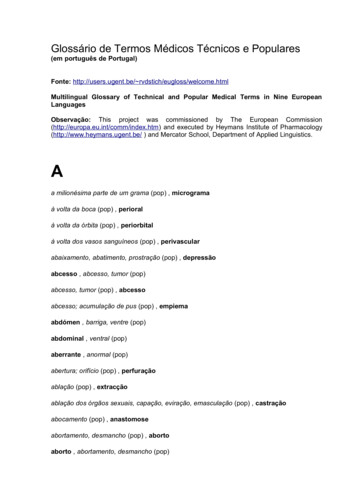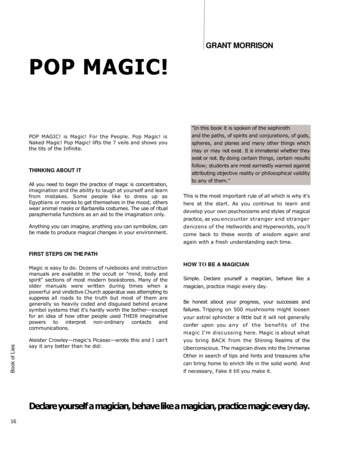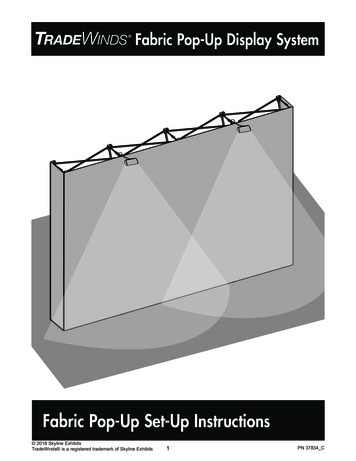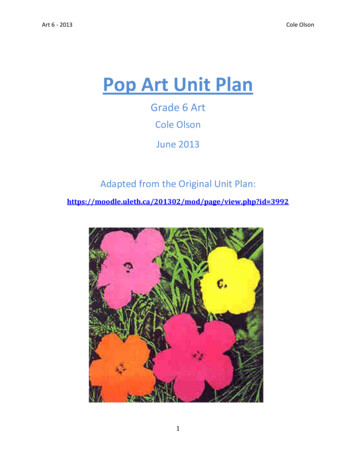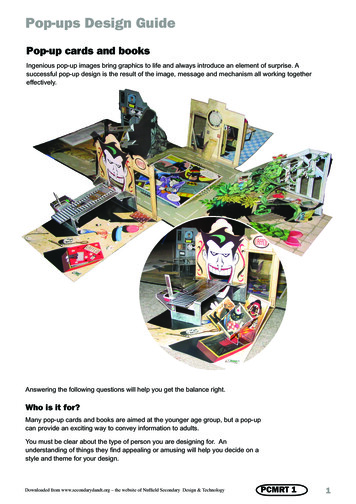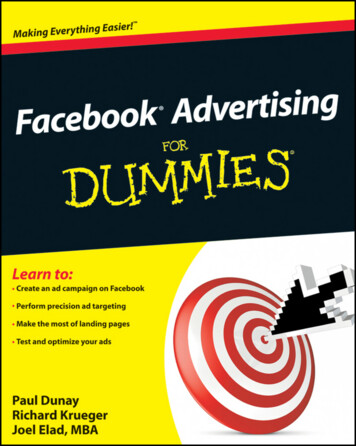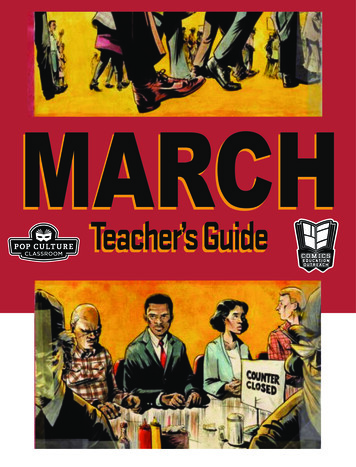
Transcription
MARCHTeacher’s Guide
TABLE OF CONTENTSINTRODUCTION LETTERS . 3PLOT SUMMARY . 5COMICS TERMS/GLOSSARY. 6VOCABULARY . 7PRE-READING ACTIVITY. 9DISCUSSION QUESTIONS.10PROJECT IDEAS.11PAIRING SUGGESTIONS.14OPPORTUNITIES FOR FURTHER LEARNING. 15TEACHER’S GUIDE 2
W H Y M A RC H ?L ET T E R O FI N T RO DUCT I O NDear Educator,After visiting the National Civil Rights Museumin Memphis during the summer of '16, I realized justhow poor of a job the schools that I had attended didof teaching students about the Civil Rights Movement.I left Memphis inspired to learn more and share thatknowledge with my students. I bought my first copy ofMarch: Book One at the Civil Rights Museum gift shopand read it on the car ride home, stopping at a local bookstore to buy Book Two before I even made it home fromMemphis.As a teacher of AP Language and Compositionand a Graphic Novel senior elective, I was going to makesure that my students experienced March. I had mycurriculum director purchase a class set of Book One andBook Two, and we were off. While you have an amazingcollection of resources in your possession here (createdby us!), there is also a good number of resources outon the inter-webs for the March Trilogy; that's where Istarted. I created a hybrid of questions and projects, abest of the best of what I had found, and my studentstook to the topic like fish to water.If I could say one good thing about our currentpolitical climate as I write this (June of '17), it would bethat students are more informed, if not just interested,about politics than any time I can remember. It'sbecause of this that March works so well in the 21stcentury classroom. My students have opinions andreactions to John Lewis' narrative, and the imagescreated by Nate Powell allow for an abundance of analysisand discussion. Thinking back on our discussions, I wish3 TEACHER’S GUIDEI had some of the projects that we have created for thispacket last school year! I can't wait to use them thiscoming year.Don't shy away from the difficult discussionsthat arise from the series, but always make sure to leadthe discussion in positive directions. If it's one thingthis book has seemed to teach my kids it's that oneperson can make a difference, and I hope March inspiresstudents and educators in your building as it has mine.-Eric Kallenborn
GET T I NG I N G O O D T ROU B L EL ET T E R O FI N T RO DUCT I O NIf you ask your students who Dr. Martin LutherKing, Jr was, you can be confident that they will spitout facts about his involvement in the Montgomery busboycotts, or how he was a civil rights leader. Some kidsmay even be familiar with his "I Have A Dream" speech,or "Letters From a Birmingham Jail." Ask who Rosa Parkswas, and many of your students will know she helpedstart the Montgomery bus boycotts by refusing to give upher seat at the front of the bus. But ask your studentswho Bayard Rustin is, or Fannie Lou Hamer, or Ella Baker,or John Lewis and chances are you might get more thana few quizzical looks. But when John Lewis decidedto tell his story, and to tell it in a way that would beaccessible to young and old audiences, he took the firststep towards making sure he left an indelible mark on theworld. He told his story and changed the world."find a way to get in the way and get in good trouble,necessary trouble." I think March can be the manual forstudents looking for the right trouble to get into.-Ronell WhitakerThe biggest takeaway my students get from Marchis the power of telling your story, and more importantly,it's using that power to affect change. Since designthinking and problem based learning have become moreprominent in education, students have even more ofan opportunity to make a positive impact on the worldaround them. Using John Lewis' early childhood as amodel, students can identify problems in their school,community, city, or even the world, and think of actions,no matter how small, to address those issues.When John Lewis was a child, his parents toldhim that there was no way to change how Black peoplewere treated. That the problem was too big. That heshould just stay out of the way, and not get in trouble.But, as his story in March makes abundantly clear,Representative Lewis knew that the only way to makea difference was to speak out, to tell one's story and toTEACHER’S GUIDE 4
M A RC HP LOT S U M M A RYCongressman John Lewis (GA-5) is an American icon, one of the key figures of the civil rights movement. Hiscommitment to justice and nonviolence has taken him from an Alabama sharecropper’s farm to the halls of Congress,from a segregated schoolroom to the 1963 March on Washington, and from receiving beatings from state troopers toreceiving the Medal of Freedom from the first African-American president.Now, to share his remarkable story with new generations, Lewis presents March, a graphic novel trilogy, incollaboration with co-writer Andrew Aydin and New York Times best-selling artist Nate Powell (winner of the EisnerAward and LA Times Book Prize finalist for Swallow Me Whole).March is a vivid first-hand account of John Lewis’ lifelong struggle for civil and human rights, meditating inthe modern age on the distance traveled since the days of Jim Crow and segregation. Rooted in Lewis’ personal story,it also reflects on the highs and lows of the broader civil rights movement.Book One spans John Lewis’ youth in rural Alabama, his life-changing meeting with Martin Luther King, Jr.,the birth of the Nashville Student Movement, and their battle to tear down segregation through nonviolent lunchcounter sit-ins, building to a stunning climax on the steps of City Hall.Many years ago, John Lewis and other student activists drew inspiration from the 1950s comic book "MartinLuther King and the Montgomery Story." Now, his own comics bring those days to life for a new audience, testifying toa movement whose echoes will be heard for generations.Source: http://www.topshelfcomix.com/catalog/march/7605 TEACHER’S GUIDE
CO M I CST E RM S/G LOS SA RYBleed - images that run outside the border of the panelBorder - edge or outline of the comic pageCaptions - contain information about a scene or characterColorist - This person gives the comic color, and add to the weight and vibrancy of the image. The colorist is oftenresponsible for helping set tone and mood via color.Dialogue Word Balloons - contain character dialogue; communication between/among charactersEmanata - text or icons that represent what is going on in a character's headFrame - lines or boxes around a panel(s)Graphic weight - a term that describes the way some images draw the eye more than others, creating a definite focususing color and shading in various waysGutters - space between panels where the reader infers movement and action between panelsPanels - squares or rectangles that contain a single scenePenciler - Primary artist. This person takes the script and draws the comic. They draw the comic in pencil which thengets inked and colored later on.Sound Effect - words that show sound is happeningThought Balloons - contain a character’s thoughtsWriter - The writer writes the story and has the overall vision of how the story will go. They write the dialogue andhow the story will progress.TEACHER’S GUIDE 6
M A RC HVO C A BU L A RYPage 6Conducive – tending to promote or assistDisperse – to spread widelyPage 22Sharecropper – a tenant farmer especially in the southern U.S. who is provided with credit for seed, tools, livingquarters, and food, who works the land, and who receives an agreed share of the value of the crop minus chargesPage 28Congregation – an assembly of persons; a religious communityPage 54Segregation – the act of setting someone or something apart from other people, places, or things.Page 56Social Gospel Movement – a religious movement that arose during the second half of the nineteenth century.Ministers, especially ones belonging to the Protestant branch of Christianity, began to tie salvation and goodworks together.Page 58Boycott – to remove yourself from social or commercial relationships as a form of protest.Page 75Non-violence/non-violent protest – a type of activism or resistance that uses methods besides violence to achieve asocietal goal: sit-ins; marches/protests; boycotts; etc.Page 76Pacifist – a person who is opposed to violence and warFellowship of Reconciliation [FOR] – a religious non-violent organizationPage 80Dehumanize – to deprive of human qualities, personality, or spiritPage 83Nashville Student Movement –Page 101Conspicuously – obviously; noticeablyPage 110Instigated – provokedPage 112Southern Christian Leadership Council [SCLC] - a group of Black churches that was formed to coordinate theactions of local protest groups throughout the country7 TEACHER’S GUIDE
M A RC HVO C A BU L A RYPage 112Student Nonviolent Coordinating Committee [SNCC] – a student run civil rights organization that remainedindependent of the other organizationsJim Crow Laws – after the Civil War, Southern Legislation passed laws of racial segregation("Jim Crow Laws") against African Americans at the end of the 19th century.Memoir – a work of non-fiction about a subject written from the perspective of that subject.Flashback – literary device where the author takes the reader back to an earlier time to furtherdevelop plot, character, setting, etc.TEACHER’S GUIDE 8
P R E - R E A D I NGACTI VI T YMartin Luther King and the Montgomery Story: http://www.crmvet.org/docs/ms for comic.pdfGandhi Speech on Non-Violence: https://www.youtube.com/watch?v dEEZsocrm0A9 TEACHER’S GUIDE
DI S CUS S I O NQU E ST I O NS1. What are some possible meanings for the title, March?2. In the opening pages, we meet John Lewis during theconfrontation with police on the Edmund Pettis Bridge.How would you characterize (using character traits thatdescribe him as a person) John Lewis?3. How does the book use flashback to connect importantmoments from the past to the present day?4. (Pg. 12-15) What is the significance of the date? Whathappened? Where is this person going? Who do you thinkhe is? How do you think he would feel about this event?Why?5. Why do you think the creators chose to use the deviceof Mr. Lewis telling his life story to the young visitors inhis office? And how does this device impact the way thatreaders perceive or understand the story?6. Page 27 contains an image of young John with a Biblescripture printed on him. What might be the significanceof this scripture to John at the time?7. What role did the chickens play in preparing John forhis life in the Civil Rights Movement?13. (Pg. 78) John is depicted all in black and just histhoughts printed on the page. Why do you think thecreators chose to depict this moment this way? What washappening at this moment for John? How did he feel?14. (Pg. 76-78) What was the point of the meeting? Whatmethod of protest were the students planning to use?Why?15. How did the protesters prepare for their protests?Why was this important? Is this something you think youwould have been able to do?16. How were the initial protests received by Whites inthe town? How did they react?17. Were the protests successful in the end? Explain whyor why not?18. Do you think non-violent protest is effective?19. How does the book end? Has segregation beendefeated? What happens?20. Last question – go back to your first answer. Nowanswer it again – why do you think this book is titledMarch?8. (Pg 36, panel 1) What advice did John's parents givefor African-Americans to survive in the South at thattime?9. (Pg. 36-47) John takes his first trip north. What weresome of the differences in quality of life for AfricanAmericans in the North and the South?a. How did John's first trip North impact him?How did it change him and why?10. (Pg. 48-52) Describe the effects of segregation onAfrican-Americans during this time. How were their livesdifferent from White people?11. (Pg. 55-56) How did hearing Martin Luther King, Jron the radio effect John? Why do you think he mentionedthe other preachers in his community on the previouspage compared to MLK?12. Detail the death of Emmett Till and how it impactedthe fight for civil rights. How did things change after hisdeath?TEACHER’S GUIDE 10
PROJ ECT I D E A #1 :W H AT ' S YOU RP RO B LE M?John Lewis saw several problems in his life andtook actions to address them. When he wanted to goto Troy University, he reached out to Dr. King for help.When he saw there were issues with integrating lunchcounters, he joined a student protest group. Morerecently, he saw that young people were disengagedfrom the civil rights movement, so he co-wrote March toengage young readers. Have students use this modifiedversion of problem based learning to address a problemin their own lives. It could be a problem in school, theirneighborhood, their home or their town.Step 1: identify the problemWhat is a problem you have in your life that youmight be able to change? This problem shouldnot be as big and broad as “racism,” rather itshould be specific and solvable. It could be inschool, your neighborhood, your home or yourtown.Step 2: research causes of the problemThe best way to find solutions to a problem is toidentify the causes of the issue and isolate thosecauses into things that can be addressed.Step 3: identify people or resources who couldbe partners in solving this problemMr. Lewis did not address his problems onhis own, and neither should you! Who are peopleor resources you could tap into to help you withyour problem? How could you reach out to themfor help?Step 4: generate possible solutions to yourproblemThis is where you think of products or actionsthat could directly address your problem. It couldbe as simple as a letter writing campaign to asambitious as a clothing drive.11 TEACHER’S GUIDEStep 5: get feedback from a classmateThis step would be a great place to getfeedback on your problem and possible solutions.Your classmates are a resource who could helpyou choose the best solution to your problemStep 6: choose a solution you could enactAfter brainstorming possible solutions, pick theone you have the most passion and ability toactually address. Generate the action steps youwould need to take to accomplish this problem.This is where the product (a letter, apresentation, a comic book, etc) comes in.Step 7: Present to classPresent your project to the class! Explain yourproblem, and the process you took to addressyour problem!
PROJ ECT I D E A #1 :W H AT ' S YOU RP RO B LE M?TEACHER’S GUIDE 12
GE N E R A L P ROJ ECT I D E A SFOR VAR I OUS CO NTE NTAREASCharacterization of John Lewis: Select one of theJohn Lewis YouTube videos listed below (or find anothervideo in which John Lewis speaks) and write a compare/contrast response comparing the John Lewis in the videoto the John Lewis that we meet in March: Book One.What similarities do we find? What differences? Is itevident that the man in the video is the same man thatthe book is about? Why or why not?Interview Project: Much of this story is written as if itwere told to a younger audience. As such, the readerwas informed about a pivotal moment in the UnitedStates' history, but it was delivered in a digestible wayfor its intended audience. At times, real history is notjust as we are taught. Find three people of differentbackgrounds that lived through the Civil Rights'Movement and interview them with seven-ten questionsthat you have created based off your reading of March:Book One (questions will be edited and approved byteacher). You will present your findings to the class.Alteration: Interviews must be typed out andproperly formatted to teacher specification.Alteration 2: After you have collected your threeinterviews, create an object that you feelexemplifies the Movement. Format the words ofyour interviews into that shape. The shape,placement, coloring, etc., is up to you! Projectmust be approved by teacher. This one takes a lotof creativity!Art Vocabulary: Select some (teacher can determineamount) of the Comics Terms/Glossary terms, and findtwo-three instances of these terms in action in thebook. Explain where it is found, what it is, and how yourexample works in the book. This can be written, oral,or a group/individual presentation. Images should beshared in some way with the class for discussion.Social Studies: Multi-media Text Set Project: Using Marchas inspiration, have students create a DBQ (documentbased question) also known as a synthesis essay packet.Students will need to discover a question based on the13 TEACHER’S GUIDEera of John Lewis; and while this question can alludeto or ask about other time periods, the framework ofthe question needs to find a solid foundation in theCivil Rights' Movement. Students will need to develop aquestion that will be accompanied by 6-8 found sourcesthat could be used to answer the question. Sourcesshould be no longer than one page; one should be animage of some sort, and one should be a chart or graph.Here is a great resource for teaching with DBQ: http://www.edteck.com/dbq/index.htmTo differentiate, allow students to create their owndocuments through research or interviews.March Vocabulary Project: select one of the MarchVocabulary terms listed above, research it, and prepare afive-seven minute presentation explaining it to the class.You can choose whatever format you wish to present youridea, but you will be graded on how well you were able toconvey the information to the classDesign March T-shirt: In an effort to find deepermeaning in a text, have students use the first panel ofpage 27 as inspiration for this project. What phrase fromthe book March or another work has stayed with themor impacted them? What is the meaning behind thatphrase? Why is it important to you? Students will puttheir powerful phrase on a t-shirt paired with the imageof their choice. (This, like many of the options here, maybe typed out if the student is not an artist.)Movie Poster: Think of your favorite movie poster. Whatmakes it memorable? What makes it pop? What makesyou want to see the film? Do some research into coolmovie posters. Find your style. Create your own movieposter for the film March! You do not need to drawthe poster, but you will need to write-up a detailedexplanation as to what the poster looks like. You canlet your imagination fly.as long as you can write downexactly what your poster would look like.
PA I R I NGSUG G E ST I O NSSelmaWe’ve Got a Job: The 1963 Birmingham Children’s MarchThe film chronicles the tumultuous three-month periodin 1965, when Dr. Martin Luther King, Jr. led a dangerouscampaign to secure equal voting rights in the face ofviolent opposition. John Lewis is a featured person inthe film. Although the film is PG-13, there is some stronglanguage at moments.We've Got a Job tells the little-known story of the 4,000black elementary-, middle-, and high school studentswho voluntarily went to jail in Birmingham, Alabama,between May 2 and May 11, 1963. Fulfilling MahatmaGandhi's and Dr. Martin Luther King, Jr.s precept tofill the jails, they succeeded where adults had failed indesegregating one of the most racially violent cities inAmerica. Focusing on four of the original participantswho have participated in extensive interviews, We've Gota Job recounts the astonishing events before, during, andafter the Children's March.Letter From Birmingham JailGive students the opportunity to read about the civilrights movement from one of its most famous actors.“Letter from Birmingham Jail” is one of the most widelyavailable civil rights artifacts, and it speaks directly tothe tenants of getting in “good trouble.”The Silence of Our FriendsIn 1960s Texas, a white family from a notoriously racistneighborhood and a black family from its poorest wardcross Houston's color line, overcoming humiliation,degradation, and violence to win the freedom of fiveblack college students unjustly charged with the murderof a policeman. This graphic novel gives a differentperspective on the injustices of the time period.TEACHER’S GUIDE 14
OP PORT U NI T I E S FO RF U RT HE R L E A R NI NG"The Comic that Changed the World" by Andrew Aydin 11/the-comic-book-that-changed-the-world“Martin Luther King and the Montgomery Story” http://www.crmvet.org/docs/ms for comic.pdf"John Lewis Speaks at the March on Washington" https://www.youtube.com/watch?v tFs1eTsokJg"John Lewis on Late Show: Get into good trouble" https://www.youtube.com/watch?v 6ATwisIrtfg"PBS American Experience: Jim Crow atures/freedom-riders-jim-crow-laws/15 TEACHER’S GUIDE
AC K NOW L E D G E M E N TSAUTHORSRonell WhitakerEric KallenbornTEACHER’S GUIDE 16
Igniting Imaginations.P O P C U LT U R E C L A S S R O O M . O R G
Mar 01, 2018 · March is a vivid first-hand account of John Lewis’ lifelong struggle for civil and human rights, meditating in the modern age on the distance traveled since the days of Jim Crow and segregation. Rooted in Lewis’ personal story, it also reflects on the highs and lo

